|
|
|
Sort Order |
|
|
|
Items / Page
|
|
|
|
|
|
|
| Srl | Item |
| 1 |
ID:
123702
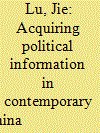

|
|
|
|
|
| Publication |
2013.
|
| Summary/Abstract |
Using complementary information from two national surveys conducted in 2008, i.e. the China Survey and the ABS II Mainland China Survey, this paper presents a comprehensive picture of the media channels that Chinese citizens use for political information, as well as their relative importance as assessed by the Chinese people. Moreover, assisted by multiple regressions, this paper also identifies which groups of Chinese are more likely to use each of these channels for political information. This paper contributes to our understanding on (1) the relative significance of various media channels in contemporary China's political communication; and (2) how Chinese citizens select themselves into specific channels for political information, given their increasing autonomy in acquiring such information from China's changing media.
|
|
|
|
|
|
|
|
|
|
|
|
|
|
|
|
| 2 |
ID:
144096
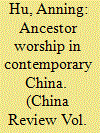

|
|
|
|
|
| Summary/Abstract |
Although ancestor worship has been widely acknowledged as one of the most significant cultural traditions in Chinese society, information about its nationwide popularity and followers’ sociodemographic characteristics is still not clear. Taking advantage of the first nationwide survey on Chinese residents’ spiritual life, this study examines: (1) the extent of popularity of typical ancestor worship practices, (2) the sociodemographic features of ancestor worship individuals, and (3) the “magical” elements of ancestor worship activities. Empirical results suggest that, first, the most popular ancestor worship practices in contemporary China are venerating the spirits of ancestors or deceased relatives and visiting the gravesite of ancestors. Ancestor worship practice participants make up over 70 percent of the adult population. Second, on average, males are more active in ancestor worship than females. Also, economic status is positively associated with ancestor worship participation. Nevertheless, urbanization and migration have a negative effect on people’s propensity of practicing ancestor worship. Third, the magical aspect of ancestor worship is less attractive to well-educated adults, but more likely to be followed by senior individuals.
|
|
|
|
|
|
|
|
|
|
|
|
|
|
|
|
| 3 |
ID:
144095


|
|
|
|
|
| Summary/Abstract |
This article draws on survey and interview data in Beijing and Guangzhou to examine the attributes, political attitudes, and political actions of homeowner activist leaders. Homeowner activist leaders are not agents of broad democratization. Instead, they are found to be supportive of Communist Party rule and value societal stability. In addition, homeowner activist leaders act like interest groups and actively seek to influence both national and local policy making. They also actively engage in expanding networks among homeowner activists and establishing forums to exchange experiences in homeowner activism. The political attitudes of homeowner activist leaders differ across localities. Compared to those in Beijing, Guangzhou homeowner activist leaders are more satisfied with government performance.
|
|
|
|
|
|
|
|
|
|
|
|
|
|
|
|
| 4 |
ID:
193189
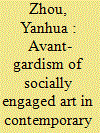

|
|
|
|
|
| Summary/Abstract |
This article sheds light on the place of avant-gardism in socially engaged art and how it is reformulated in practice, through critically examining the art practices of the Yangdeng Art Cooperatives, a socially engaged art project in a rural area of Southwest China, where artists create various collaborative artworks and site-specific projects with the local people. I argue that the project contributes to an avant-garde mode of socially engaged art through aestheticizing the ordinariness of the everyday. I term this process ‘ordinary aesthetics’. This term demonstrates potential connections in our everyday lives and redefines the relationship between aesthetics and politics by regarding aesthetics as a perceivable sensate and a distribution of the sensible. In aiming to promote the ordinary, artists engage in local residents’ everyday lives by transforming their ordinary objects, spaces, and incidents into works of art. It is art that makes their ordinariness extraordinary. Technically, the artists blur the boundary between the real and the fictional to aestheticize the everyday lives of local residents. In their practices, ordinary aesthetics consequently becomes a means to rediscover the avant-gardism of socially engaged art.
|
|
|
|
|
|
|
|
|
|
|
|
|
|
|
|
| 5 |
ID:
149313


|
|
|
|
|
| Summary/Abstract |
This article investigates the temporal trend in the socioeconomic differentials between ethnic minorities and the Han majority in China. Data from a series of population censuses and a mini-census show that, while the regional distribution of ethnic minorities remained relatively stable from 1982 to 2005, occupational segregation and educational disparities between minorities and the Han increased over time. Multivariate analysis of data from the 2005 mini-census further reveals that ethnic minorities were disadvantaged in earnings in urban labor markets compared to the Han, especially those minorities in the private sector and in self-employment. The analysis also uncovers substantial heterogeneity among ethnic minorities in their socioeconomic relationship with the Han and presents a comprehensive picture of how various ethnic minorities have fared in the course of China’s economic transition.
|
|
|
|
|
|
|
|
|
|
|
|
|
|
|
|
| 6 |
ID:
107185
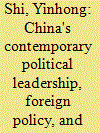

|
|
|
|
|
| Publication |
2011.
|
| Summary/Abstract |
There have been several profound features embedded in the contemporary Chinese political leadership, all having their roots in the Chinese centuries-long traditions or the modern/contemporary creative practice, together with their shaping impacts upon China's foreign policy or remarkable reflections in her external behavior. They are: reforms inherently differentiated; central idea of "maintenance", notion of "biological circle governing universe", paradox in the question of equality, the emphasis on morality, overwhelmingly domestic function of foreign policy, firm belief in the Chineseness per sue and its overwhelming importance, and political prudence in the perennial context of "Strong China, Weak China." China is facing enormous domestic historical challenges and substantial international pressure, while a generally peaceful China can be assured at least from her self-regarding realistic perspective.
|
|
|
|
|
|
|
|
|
|
|
|
|
|
|
|
| 7 |
ID:
128269


|
|
|
|
|
| Publication |
2014.
|
| Summary/Abstract |
The study of Chinese political economy has experienced a sea change since the late 1990s; instead of debating the origins and direction of national reform, scholars have turned to examining the origins of local economic variation. This article reviews recent work in the regional political economy of contemporary China. In keeping with a movement in comparative politics toward analyzing subnational politics, the "new regionalists" seek to identify and explain meaningful heterogeneity in the Chinese polity and economy. Yet they go further than simply using subnational cases to generate or test theories about Chinese politics. Instead, they propose that subnational political economies in China are a function of endogenous change rather than a reaction to national priorities. After identifying differences between the "new regionalism" and previous studies of decentralization in China, the author discusses this work according to the theoretical approaches (institutional, ideational, and sociohistorical) used to explain the origins of regional differences. She concludes by examining the limitations of the new regionalist agenda in comparative and historical context and suggesting that scholars move past unconditional acceptance of the causal power of "socialist legacies" and instead attend to the importance of changes in the post-Mao administrative hierarchy.
|
|
|
|
|
|
|
|
|
|
|
|
|
|
|
|
| 8 |
ID:
107167
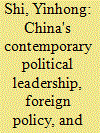

|
|
|
|
|
| Publication |
2011.
|
| Summary/Abstract |
There have been several profound features embedded in the contemporary Chinese political leadership, all having their roots in the Chinese centuries-long traditions or the modern/contemporary creative practice, together with their shaping impacts upon China's foreign policy or remarkable reflections in her external behavior. They are: reforms inherently differentiated; central idea of "maintenance", notion of "biological circle governing universe", paradox in the question of equality, the emphasis on morality, overwhelmingly domestic function of foreign policy, firm belief in the Chineseness per sue and its overwhelming importance, and political prudence in the perennial context of "Strong China, Weak China." China is facing enormous domestic historical challenges and substantial international pressure, while a generally peaceful China can be assured at least from her self-regarding realistic perspective.
|
|
|
|
|
|
|
|
|
|
|
|
|
|
|
|
| 9 |
ID:
132737
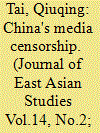

|
|
|
|
|
| Publication |
2014.
|
| Summary/Abstract |
Media censorship is the hallmark of authoritarian regimes, but much of the motivation and practices of autocratic media censorship still remain opaque to the public. Using a dataset of 1,403 secret censorship directives issued by the Chinese propaganda apparatus, I examine the censorship practices in contemporary China. My findings suggest that the Chinese Communist Party (CCP) is gradually adjusting its censorship practices from restricting unfavorable reports to a strategy of "conditional public opinion guidance." Over the years, the propaganda apparatus has banned fewer reports but guided more of them. However, this softer approach of regulating news is not equally enforced on every report or by different censorship authorities. First, the party tends to ban news that directly threatens the legitimacy of the regime. In addition, due to the speed with which news and photographs can be posted online, the authorities that regulate news on the Internet are more likely to ban unfavorable reports, compared with authorities that regulate slower-moving traditional media. Lastly, local leaders seeking promotions have more incentive to hide negative news within their jurisdictions than their central-level counterparts, who use media to identify misconduct among their local subordinates. Taken together, these characteristics create a strong but fragmented system of media regulation in contemporary China.
|
|
|
|
|
|
|
|
|
|
|
|
|
|
|
|
| 10 |
ID:
133997
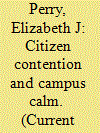

|
|
|
|
|
| Publication |
2014.
|
| Summary/Abstract |
Civil society in contemporary China presents a perplexing paradox. Despite the brutal suppression of the 1989 Tiananmen uprising, social contention and associational activism swelled over the ensuing years. One might have expected the ruthless June Fourth repression of the massive student movement to have deterred subsequent dissent, but in fact the frequency of protest has steadily escalated in the past 25 years. Moreover, China today is host to countless grassroots (as well as government-sponsored) nongovernmental organizations (NGOs), foundations, and charities-not to mention a vibrant sphere of online public debate. In contrast to 1989, a nascent civil society can now be said to exist.
|
|
|
|
|
|
|
|
|
|
|
|
|
|
|
|
| 11 |
ID:
131644
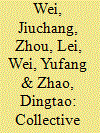

|
|
|
|
|
| Publication |
2014.
|
| Summary/Abstract |
Mass incidents are inevitable in contemporary China and the first thing we should learn is to adopt a correct attitude towards them. Based on the three elements-activity, interaction and sentiment-of collective behaviors in 52 mass incidents in China during 2007-2011, we find that collective behaviors in mass incidents show significant differences in activity, interaction and sentiment. A grade evaluation method is proposed to estimate the evolution of collective behaviors in 52 mass incidents and to classify such behaviors into five grades. Then the influence factors on the three elements are analyzed using multiple linear regression. The regression results demonstrate that the impacts of location, casualties, inner-group relations, group scale and duration on the three elements are very significant. Finally, in the light of the regression results, some implications of collective behavior in mass incidents are proposed for the relevant authorities in responding to mass incidents.
|
|
|
|
|
|
|
|
|
|
|
|
|
|
|
|
| 12 |
ID:
161518


|
|
|
|
|
| Summary/Abstract |
In recent years, five historic Chinese Communist revolutionary sites—Shanghai, Jinggangshan (Jiangxi province), Zunyi (Guizhou province), Yan’an (Shaanxi province) and Xibaibo (Hebei province)—have been labeled as the most sacred sites in the history of the Chinese Communist Party (CCP) by local officials in order to promote tourism and patriotic education among young people. This widely publicized state campaign has been undertaken in an era of reform driven by unbridled capitalistic market forces when Communist ideology is losing its magnetic pull. However, the official promotion of these old revolutionary sites reveals several sharp areas of tension in today’s China: ‘red tourism’ (exploiting the heritage of the CCP for the tourism industry) versus ‘green tourism’ (scenic sightseeing for personal gratification), Communist ideology versus a market economy, and state domination versus local autonomy.
|
|
|
|
|
|
|
|
|
|
|
|
|
|
|
|
| 13 |
ID:
153388
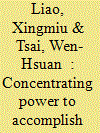

|
|
|
|
|
| Summary/Abstract |
This article discusses the operations of the Chinese Communist Party (CCP) pishi system from the perspective of decision making. As an authoritarian regime, the CCP ‘concentrates power to accomplish big things’, demonstrating the extent of the CCP’s state capacity. This article argues that, through a wide range of documentation, the CCP provides leaders with a channel for resource accumulation, to issue pishi (written directives). Next, mishu (secretaries) play an extremely important role in the transmission of documents and the execution of pishi. This article then goes on to point out that the CCP’s practice of nomenklatura is a key means to ensure that pishi are executed as expected. Finally, this article discusses the advantages and disadvantages of the pishi system.
|
|
|
|
|
|
|
|
|
|
|
|
|
|
|
|
| 14 |
ID:
174197
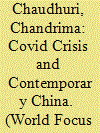

|
|
|
|
|
| Summary/Abstract |
This Year Spring festival (Chun Jie) celebration of New Year 2020 in China, also marked as Rat Year in the mandarin calendar, has led to much discontent and mourning amongst its people. As it is already evident across the world, the unexpected outbreak of Corona virus has caused number of deaths in China and the world.
|
|
|
|
|
|
|
|
|
|
|
|
|
|
|
|
| 15 |
ID:
175591
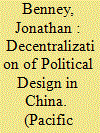

|
|
|
|
|
| Summary/Abstract |
Political posters, banners, and similar objects are extremely common in China. This article uses political design from contemporary China, particularly emphasising the government’s Chinese Dream campaign, to analyze what at first appears to be a paradox. The subjects of the campaigns and the language they use are mandated by the central government and promoted through central and local publicity departments. But the graphic aspects of these campaigns, such as the choice of colours, images, layout, and typeface, are much less strictly controlled, and are decided by local governments or authorities. This makes political design in China decentralized. Decentralized design is inconsistent with the principles of global marketing and with the PRC’s reliance on set forms of political discourse, both of which rely on the assumption that uniformity will lead to more effective communication of messages and persuasion of the public. Evidence from local design campaigns indeed shows that Chinese political posters are often designed hastily and without expertise, resulting in strange and unpersuasive images. Despite this, this article shows that decentralized design is not paradoxical. This is largely because the Chinese party-state uses propaganda as a method of “signalling” its overall power, more than as a tool of indoctrination or persuasion about particular topics. The central government’s reliance on incentives and metrics to regulate local authorities also means that the production of propaganda is also a means by which local governments can signal their loyalty to the Centre.
|
|
|
|
|
|
|
|
|
|
|
|
|
|
|
|
| 16 |
ID:
128275
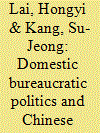

|
|
|
|
|
| Publication |
2014.
|
| Summary/Abstract |
One of the outstanding features of China's domestic politics is the prominence of the bureaucracy in the policy-making process. Arguably, bureaucracy is the next major player in the policy-making process in China after the top leaders. In this article, the three following aspects of the role of bureaucracy in the Chinese foreign policy-making process are examined: (1) the structure of the bureaucracy, especially the main agencies of the bureaucracy involved in foreign policy making; (2) the respective responsibilities of these agencies and their roles in the process; and (3) inter-agency coordination including the resolution of conflict among them. It observes that while the Ministry of Foreign Affairs plays a key role in the process, other ministries and bureaucratic agencies have significant and even growing input in an increasing number of functional areas, such as trade, finance, economy, climate change, soft power and military affairs. In addition, coordination among these agencies has become a key in the policy-making process.
|
|
|
|
|
|
|
|
|
|
|
|
|
|
|
|
| 17 |
ID:
184998
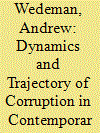

|
|
|
|
|
| Summary/Abstract |
Analysis of the data on the anti-corruption crackdown launched by Xi Jinping in late 2012 and early 2013 shows that its primary effect was to dramatically increase the number of senior officials—popularly known as “tigers”—charged with corruption. Heretofore, much of the debate about the crackdown has focused on who was been taken down and why. In this article, I shift the focus away from the “who” and “why” questions to a deeper question: what led to the proliferation of tigers? That is, how did corruption spread among the senior ranks of the party-state? Drawing on data on the tigers’ involvement in corruption, I argue that corruption was “promoted” upward during the years that preceded Xi’s crackdown. Xi’s fight with corruption has thus been a battle with corruption that spread first among the middle ranks of the party-state and then moved upward into the leadership as corrupt officials rose up through the ranks.
|
|
|
|
|
|
|
|
|
|
|
|
|
|
|
|
| 18 |
ID:
118419
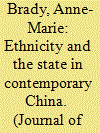

|
|
|
| 19 |
ID:
185005
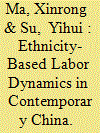

|
|
|
|
|
| Summary/Abstract |
Existing studies have mainly focused on the labor politics of migrant workers but have inadequately accounted for ethnic minority workers, especially with regard to the importance of ethnicity to labor control and resistance. This article focuses on ethnic Yi workers in the Pearl River Delta area of China. By examining the co-ethnic brokerage of ethnic Yi migrant workers, this article illustrates that ethnicity operates in labor control and resistance from three aspects. While ethnicity is used by managers and co-ethnic Yi brokers to implement labor control, it also plays multiple roles in Yi workers’ resistance. Ethnicity is the collective identity forming the Yi workers’ solidarity. Additionally, ethnicity is the instrument used by ethnic Yi brokers to gain their own benefits. Over time, the ethnic interest of group members is compromised by brokers to retain their long-term relationship with factories. Analysis of this complicated picture contributes to the existing studies of labor politics by showing the dynamics of ethnicity in labor control and resistance on the one hand and the complex roles of co-ethnic brokerage on the other hand.
|
|
|
|
|
|
|
|
|
|
|
|
|
|
|
|
| 20 |
ID:
174400
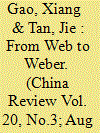

|
|
|
|
|
| Summary/Abstract |
This article argues that the state-society relations in China's digital era are shaped not only by the communication between the citizens and governments but also by the interactions among different levels of governments. Without formal power to keep the government in check, citizens may gain a louder voice through ICTs, yet exert a limited impact on policymaking. Based on a review of policy documents and an in-depth case study of the "One-Go at Most" reform in Zhejiang province, this research argues that the intervention of upper-level governments changes how the citizens and governments interact at the local level. First, the provincial party-government conducts online citizen surveys to collect information on the local governments, aiming to ensure the full implementation of the reform agenda. This strategy also equips the citizens with informal power, which forces the municipal and county governments to be more responsive and accountable with regard to efficient service delivery. Second, the provincial government has initiated the virtual government program to consolidate the new administrative procedures and standards into the cage of codes. This digitalized iron cage constrains the local cadres' discretion and establishes an e-monitoring system. The case of "One-Go at Most" in Zhejiang province provides a vivid example of how top-down mobilized digitalization can lead to a Weberian administrative system that is rational, routinized, and impartial. It is worth noting that the digital iron cage mainly exerts constraints on the administrative system. Stateled digitalization does not lead to formal power sharing between the state and society. This article concludes that the digital Weberian bureaucracy leads to the consolidation of the state's infrastructure power, and the question of whether or not this will facilitate the state's despotic power requires further exploration.
|
|
|
|
|
|
|
|
|
|
|
|
|
|
|
|
|
|
|
|
|